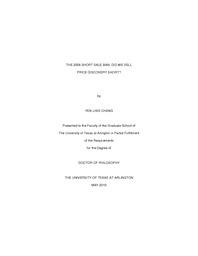| dc.contributor.author | Chang, Yen-Ling | en_US |
| dc.date.accessioned | 2010-07-19T19:54:45Z | |
| dc.date.available | 2010-07-19T19:54:45Z | |
| dc.date.issued | 2010-07-19 | |
| dc.date.submitted | January 2010 | en_US |
| dc.identifier.other | DISS-10634 | en_US |
| dc.identifier.uri | http://hdl.handle.net/10106/4909 | |
| dc.description.abstract | This dissertation investigates the impact of a short sale ban on the stock market and the options market and the interrelation between the two markets during the US financial crisis of 2008. The first essay focuses on the impact of the short sale ban on financial stocks between September 18, 2008 and October 8, 2008. I examine how daily returns responded to the ban. Non-banned firms with similar sizes and standard deviations of past stock returns as the banned firms served as a control group. An event study shows significant positive cumulative abnormal returns which might indicate that the banned firms were overvalued during the short sale ban. Cross-sectional multivariate regression analysis suggests that the driving force of stock overvaluation was the market's inability to allow operation of differing beliefs. The second essay investigates the response of the options market to the short sale ban. Only stocks on which options are traded are selected from among banned and control firms. I use put-call parity to examine whether there is a price discrepancy between implied stock prices and actual stock prices before and after the short sale ban. The results show a significant difference between actual stock prices and implied stock prices for banned firms and control firms during and after the short sale ban, although determinants of the discrepancy are inconclusive. The third essay links the options market with the stock market to examine information propagation. I use a vector error correction model to examine the lead-lag relation between prices in stock and options markets. There are two different approaches to investigate the price discovery process: (1) Hasbrouck's (1995) information share model and (2) Gonzalo and Granger's (1995) permanent-transitory model. The results indicate that stock and options markets for banned firms are interconnected through a common factor, but both two decomposition methods show that the stock market dominates in the price discovery process. | en_US |
| dc.description.sponsorship | Sarkar, Salil | en_US |
| dc.language.iso | EN | en_US |
| dc.publisher | Finance & Real Estate | en_US |
| dc.title | The 2008 Short Sale Ban: Did We Sell Price Discovery Short | en_US |
| dc.type | Ph.D. | en_US |
| dc.contributor.committeeChair | Sarkar, Salil | en_US |
| dc.degree.department | Finance & Real Estate | en_US |
| dc.degree.discipline | Finance & Real Estate | en_US |
| dc.degree.grantor | University of Texas at Arlington | en_US |
| dc.degree.level | doctoral | en_US |
| dc.degree.name | Ph.D. | en_US |
| dc.identifier.externalLink | https://www.uta.edu/ra/real/editprofile.php?onlyview=1&pid=617 | |
| dc.identifier.externalLinkDescription | Link to Research Profiles | |

